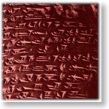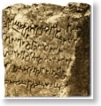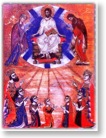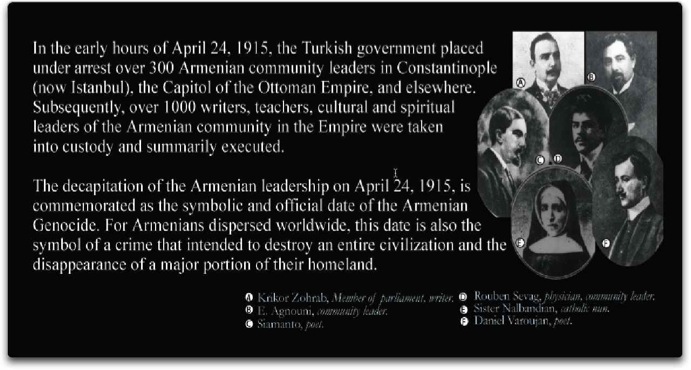TIMELINE OF ARMENIAN
LANGUAGE
4000 BC (circa):
Estimated time-table for the beginning of the
divide of an original Indo-European language
into separate linguistic paths. The identity
and original location of this culture is the
subject of much speculation.
3500 (circa):
Proto-Armenian tribes develop a culture that
evolves around agriculture, metal working and
animal husbandry. Recent archeological
discoveries highlight several agreements
between this thriving civilization in the
Armenian highland and Indo-European
culture.



300 - 100 BC: Works on language by Plato and Aristotle provide the first grammatical textbooks. The “Art of Grammar” by Dionysius of Thrax serves as the model to arrange the fundamentals of Armenian grammar.

405 (Circa): Invention of the Armenian Alphabet by Mesrob Mashdots, under the auspices of King Vramshabouh and Sahag, the Catholigos. Details of the birth of the letters are described by Gorune in “Life of Mashtots”.
405 - 500: Golden Age of Armenian language and literature.

- David, becomes the first Armenian grammarian to question the fundamentals articulated by Dionysius Thrax and develops his own theories on language, grammar and etymology.
- Two separate groups of linguists/writers embark on identifying and translating important works of the era from other centers of learning.
425: First translation of the Bible into Armenian. A second revision of the Armenian Bible from Aramaic and Greek texts finalizes the translation.
8th Cent.: A series of Sharagans (hymns) help develop Armenian poetry dedicated to spirituality. Among many noted authors are two female poets: Sahagtought Sunetsi and Khosrovitought Koghtnatsi. Stepanos Sunetsi (735) pioneers Armenian phonetics and pronunciation. He elaborates the principles for the precise articulation of separate sounds and syllables and makes the first classification of Armenian vowels and diphthongs.



12th - 13th Cent.: Vernacular Armenian spreads into literary works. First attempts to improve the system of declension and simplification of syntax are made.
- M’khitar Kosh and Vartan Aykegtsi revive the traditions of the ancient Armenian folklore by writing fables in middle (proto-modern) Armenian prose.
1200 : The “Art of Writing” by Aristakes kritch includes scientific remarks on the spelling of difficult or borrowed words. His orthographic principles serve as the basis for subsequent orthographies.
1269: Vartan Areveltsi writes two of his grammatical works in Ashkharhapar (vernacular Armenian). His “Parts of Speech” is the first methodical attempt to articulate the principles of Armenian syntax. Incidentally, Areveltsi predicts that the languages will disappear in the future and humanity will use one language.
- In a valuable textbook,
Hovhannes Yerzngatsi
challenges
Plato’s
contention of the divinity of languages by
considering language a human achievement and
not a divine invention. He also believes that
grammar helps to eliminate obstacles between
human thought and speech.
-
Gregory of Datev
revises the definitions in the works of
Arisdages
and
Kevork Skevratsi
and makes new suggestions on improving
orthography and the cases of declension.
-
Hagop Khrimetsi
writes “About
the Stress and Interrogation
Mark”,
a well-known work on the Armenian language in
the medieval period.
-
Essai Nshetsi
finishes his work “The
Definition of Grammar”.
- “A
Brief Study of Grammar”
by
Arakel Sunetsi
pays attention, for the first time, to the
biological basis of speech.
1301:
Among the great number of
Kevork Skevratsi’s
works are three grammatical texts related to
the principles of syllabification,
pronunciation and orthography.
15th
– 17th Cent.:
After the fall of the Armenian Kingdom of
Cilicia in 1375, repeated destruction of
Armenian monasteries and dispersion of the
Armenian population by Memluk, Mongol, Tatar
and Turkic tribes disrupted the cultural
evolution of Armenians.
16th & 18th Cent.:
The dire conditions of the Armenian homeland
offer the opportunity to
Kousans
(lyrical singers) to gradually imprint poetry
with secular outlook.
Ghazar Sepasdatsi,
Vrtanes Srngetsi,
Gregory of Van,
Stepanos Varaketsi,
Nerses Mokatsi,
Stepanos
and others deal primarily with the
preoccupations of Armenian populations living
under the yoke of Persian and Turkic rulers.
Later,
Sayat Nova,
the poet/troubadour, paves the way to a new era
in Armenian poetry.


- Printing houses are established in Venice (1511), Amsterdam and Marseille.
- Foundation of Mekhitarist monastery in Venice in 1717. The stated mission of the monastery is “The spiritual enlightenment of the Armenian Nation”.
- First Armenian newspaper, Aztarar, is published in 1794 in Madras, India.
- Institutions of higher learning with secular outlooks are established. Lazarian Institute is founded in Moscow (1815). Samuel Mourad College is established in Paris (1837).
19th Cent.: The division of the Armenian homeland between Russian and Ottoman Empires leads to the beginning of two separate Armenian cultural hubs centered in Tiflis (Tiblissi) and Constantinople (Istanbul).

1920: A small portion of the Armenian homeland becomes part of the Soviet Union. In the following 50 years limitations on intellectual freedoms and Stalinist purges disrupt the normal evolution of the progress of Eastern Armenian version of modern Armenian language.